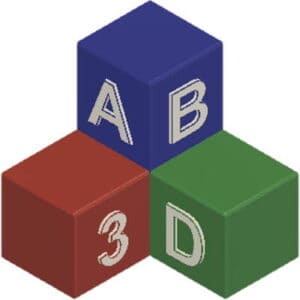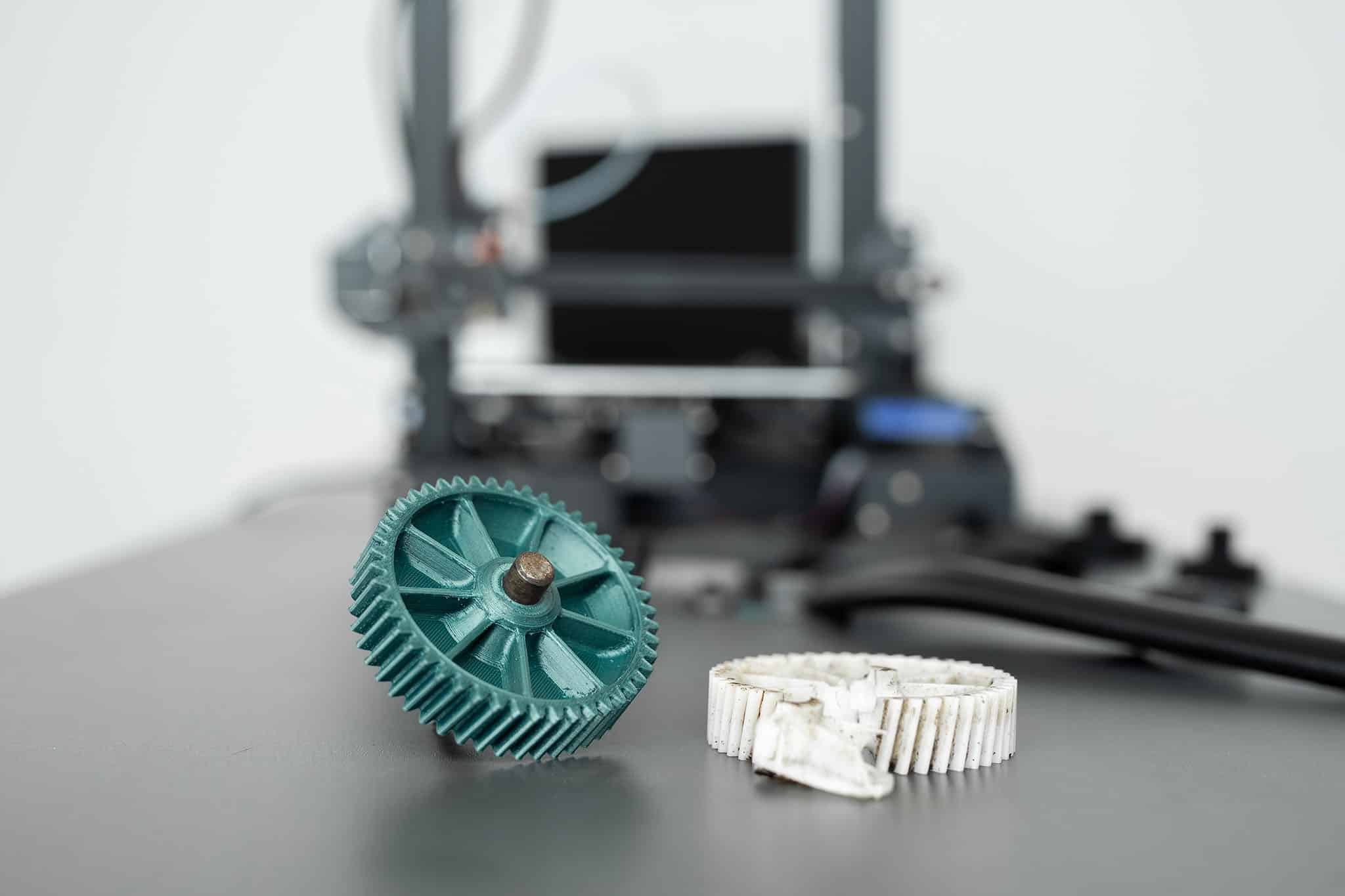This post is also available in:
![]()
When people think of 3D printing, many automatically think of printing replacement parts. I myself have already created one or the other replacement part for devices for which the manufacturer no longer provided spare parts.
Nevertheless, the question arises, is it even allowed to print spare parts just like that? If the spare part is designed and printed for personal use, there are no legal issues. Printing a part for someone else who has designed it for their own personal use is a gray area, but generally not a problem. However, designing and distributing spare parts without the consent of the rights holder is illegal.
There are many different points to consider regarding when and under what circumstances replacement parts may or may not be 3D printed.
Please be sure to read the disclaimer at the end of the blog post.
Is it allowed to print spare parts?
As long as the spare part was designed and printed for your own use, this is usually not a problem. Even if, strictly speaking, copyrights and patents would be infringed here. As long as the part is not sold commercially, but used exclusively for private purposes, no one will usually take legal action.
So if, for example, the lid of a skipping rope handle breaks, you can easily design and reprint a replacement part for your personal use. The same applies to lost or broken parts of blenders or hinges for old pieces of furniture. As long as you print these parts for yourself or possibly for people within your family and do not distribute them, everything is ok.
The same applies to the corresponding 3D models. As long as these remain with you and you do not make them available to third parties in any way online or offline, you are on the safe side.
Occasionally, there are also manufacturers who provide 3D models for replacement parts and additional accessories online. Sometimes for free, sometimes for a fee. Since the files were intentionally published by the respective manufacturer, the parts can also be printed without hesitation. However, this does not automatically mean that these parts can be sold commercially.
Two very reputable representatives in this regard, at least in the German speaking area, are Miele and Ikea. Miele offers 3D models for various accessories for vacuum cleaners and other products under the name Miele 3D4U for download on Thingiverse. Ikea Israel offers 3D models for selected furniture pieces under the ThisAbles project to make them easier to use for handicapped individuals.
Can I print spare parts for others?
If you are responsible for both designing and printing the replacement part, then it is your obligation to ensure that you are not committing any copyright or patent infringements. The full responsibility lies with you. If you have secured yourself sufficiently, there is nothing against it. However, I would recommend to get any kind of written confirmation, that you are allowed to do so. If you don’t have any commitments, you’d better stay away from printing it.
If another person provides you with the 3D model and you are only supposed to print the spare part, it is your responsibility to secure yourself and, if necessary, to obtain written confirmation that this person has ensured that all clarifications regarding copyright and patent law have been made.
I personally have always handled it this way in both above-mentioned cases: if it was a replacement part for an item that was already 20 years or older, I simply designed and printed the parts myself. For items of this age, such as this replacement gear for an old cassette recorder, you usually can’t get replacement parts from the manufacturer. The question is, if the manufacturer still even exists.
For those few manufacturers who provide 3D models for printing spare parts and additional accessories, the printing of such parts is usually also permitted for third parties. You may also charge an expense allowance for materials, etc. here, of course only in the context of a commercial activity.
These parts, however, can rarely be used as a basis for a business model to sell to third parties. Make sure to check under which license the model was published. Checking with the manufacturer would also be advisable.
Is it allowed to sell 3D printed spare parts?
If you have legally secured yourself, for example, through a written agreement with the manufacturer, then it is not a problem. As mentioned several times before, this is only possible in a commercial context.
If the 3D printed parts are for old electrical appliances that are 20 years or older, such as old tape recorders, record players, etc., in my personal opinion, it is not a problem, especially if the manufacturer no longer provides replacement parts. Legally, it is more of a gray area, but in case of doubt, it is certainly not a bad idea to contact legal representation or the corresponding manufacturer, if they still exist.
For all those manufacturers who make their 3D models available for 3D printing of spare parts or accessories, it is only rarely allowed to sell these spare parts. However, this does not mean that no compensation for the printing may be requested. Make sure to check under which license the model was published and, if necessary, contact your legal representation before offering these parts for sale.
Can I sell 3D models for spare parts?
If you have written permission from the copyright holder or, where applicable, the patent holder, then you may of course sell the 3D models as agreed. Provided of course that you do this in the context of a commercial activity.
If you have designed a spare part yourself for an old item or device for which the manufacturer no longer provides spare parts, this is usually not a problem. However, it is still no bad idea to clarify this issue with the manufacturer in case of doubt.
If the 3D model has been provided by the manufacturer himself, it is essential to clarify under which license the model has been published and whether a sale is permitted. As a rule of thumb, however, this is prohibited.
Can I upload 3D models for spare parts to platforms and make them available to others?
If you have a written consent from the copyright or patent owner, you may do so. As long as you are not selling the 3D models on platforms, the commercial context does not apply here.
If you have designed a replacement part for an old device, an old piece of furniture or any other object and have also clarified with the manufacturer that you can make it available online to the public, then you can certainly do so. One option in addition to the major platforms like Thingiverse and MyMiniFactory is the German project 3D Druck & Reparatur, which specializes in providing replacement parts.
Translation: For manufacturers that provide 3D models for printing replacement parts themselves, it would be advisable to encourage the manufacturer to publish the parts themselves on the appropriate platform. This is because it ensures that the parts are updated by the manufacturer if necessary.
Am I allowed to modify a spare part and then sell it?
Even if it has been ensured that there is no violation of any patents, design patterns, copyrights, or trademarks, the legal situation is not completely clear. Especially if your replacement part is used to repair defective and patented devices, there may be a legal violation.
In this case, it is also advisable to contact a legal advisor and/or the manufacturer or patent holder.
Do I have to take responsibility for damages caused by 3D printed replacement parts?
You will voluntarily assume liability for the replacement part you have created, simply due to your reputation. This is unless the part has become defective through improper handling or normal wear and tear. In most cases, you are creating a replacement part for an already defective device. Therefore, the damage caused by a defective or ill-fitting replacement part in the private sphere is usually manageable. The device or piece of furniture remains defective. Only the costs of your service may need to be reimbursed.
This statement only refers to the area of end-users. If you are printing small series of replacement parts for someone, the situation can be very different. In this case, however, it is definitely necessary to have a conversation with your business partner and, if necessary, seek legal counsel.
Disclaimer
The information provided in this blog post has been researched to the best of my knowledge and belief. However, as mentioned several times throughout the post, the information mainly reflects my personal opinion and should not be understood as a recommendation. These statements have no legally binding effect.
If any of the above-mentioned information is applied, it is done expressly at the discretion of the respective person. AB3D assumes no liability for any resulting property and/or personal injury, as well as copyright or patent infringements.
In case of doubt, therefore, legal counsel and/or the relevant manufacturer or patent holder should always be consulted.


